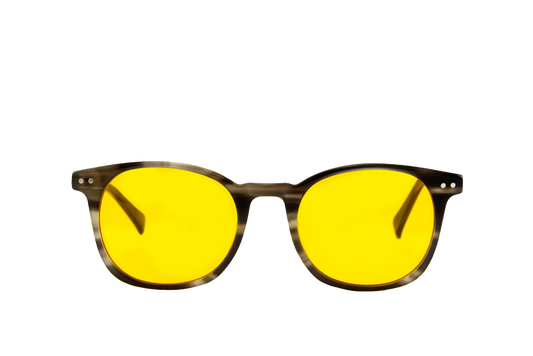Dry Eye Syndrome: What Causes Dry Eyes And How Is It Treated?
Andy MantDry eyes are a bother. They’re painful, seemingly occurring without cause, and can leave you asking, ‘Why are my eyes so dry and itchy?’
Well, you can’t solve a problem you don’t know, right?. In this article, we will guide you through the types of dry eye, their causes, and recommended treatments so that you can understand dry eye and hopefully find relief.
What Causes Dry Eyes?
Tears, apart from being a physical expression of emotion, play another important role — eye lubrication. Dryness of the eyes comes about when your eyes are not getting adequate lubrication, either due to low volume or low quality of tears.
Tears normally form a protective sheath over the eyes, known as a tear film. When this film is damaged or not well formed, your eyes feel dry and blurry.
The tear film consists of three layers:
- The lipid/oily layer (outermost)
- The aqueous layer (intermediate)
- The mucus layer (innermost layer)
Each of these layers works in tandem to maintain a well-moisturized eye.
The mucus layer is the innermost layer of the tear film. The mucus that makes up this layer is made in the conjunctiva, a thin membrane covering the white part of your eye and the inner side of your eyelids. The mucus layer clings to the eye’s surface and is partially mixed with the watery (aqueous) layer, helping keep the eye moist. Without the mucus, tears would quickly slide off the eye’s surface, leaving behind dry, gritty eyes.
The aqueous layer is the middle layer of the tear film. It mainly contains water (98%) but also carries other substances such as proteins and hormones. This layer makes up the bulk of the tear film and performs most tasks — washing away dirt, lubricating the eye surface, and carrying nutrients and oxygen to the cornea.
The lipid layer is the outermost layer of the tear film. This layer shields the aqueous layer from direct contact with air, preventing the evaporation of liquid, which is what causes dry eyes. The absence of the lipid layer would cause moisture to evaporate 20 times faster. Another function of this layer is to seal the tear film, preventing tears from rolling away.
You Ask: Why Do My Eyes Get Dry?
Your eyes get dry when the protective tear film that lubricates your eye is compromised. When this tear film is damaged, air gets into contact with the eye surface, causing a feeling of dryness and irritation.
Types of Dry Eye And Their Causes
1. Aqueous Deficient Dry Eye
This dry eye occurs when the tear film lacks enough water.
Causes of Aqueous Deficient Dry Eye:
Most common causes:
- Hormonal changes - As we advance in age, the levels of different hormones in our bodies change. These changes affect many processes in the body, such as the production of tears. Older people, whose hormones have dropped significantly, tend to suffer from dry, itchy eyes. Change in hormones is also why women tend to notice dry eye 20-25 years before their male counterparts and after menopause.
- Sensory impairment - Normally, when the eyes are dry, nerves are supposed to sense the dryness, transmit that information to the brain, and send a signal back to the lacrimal glands to produce more tears. Sometimes, this mechanism is impaired by infection, trauma, or eye surgery. When this impairment happens, the eyes can become dry.
- Medications - Some systemic medications have a drying effect on the body. An example of these medicines are antihistamines for allergies. These drugs may cause you to urinate more, which lowers the water content of the body. Low body-water content can then lead to insufficient tear production.
2. Evaporative Dry Eye
With evaporative dry eye, the tear film evaporates too quickly, leaving the eye surface under-moisturized. Even if the eyes produce enough liquid, dryness can occur if it evaporates faster than it is being produced.
Causes of Evaporative Dry Eye
Most common causes:
- Environmental factors - An increase in temperature, whether from the sun or indoor heating, will lead to faster evaporation of the tear film, which in turn causes eye dryness. Airflow also plays a part in drying out the eyes. Fast winds or air conditioning, for example, are bound to cause faster evaporation of tears.
- Poor blink rate / Incomplete closure - When in a natural setting, such as conversing with a friend, a person blinks about 20 times a minute. However, the blink rate drops to about five times a minute when we use devices. As a result, the tear film is exposed to the air for longer than usual, causing it to dry out.
In addition to poor blink rate, some people do not fully close their eyes when they blink, meaning the tear film never gets fully replenished. A more severe case of this is lagophthalmos, a condition where people cannot completely shut their eyelids, even when sleeping.
- Meibomian gland dysfunction (MGD) - This condition is related to the incomplete eye closure discussed above. The glands that produce the oil part of the tear film are known as Meibomian glands. The secretion of oil from these glands happens when you blink fully. What causes dry eyes is the condition when someone has difficulty blinking fully. During a partial blink, oil is not produced; therefore, the tear film has no protection against evaporation. Additionally, when you don’t blink enough and don’t blink fully, these oils can get clogged, causing inflammation of the eyelid. This leads to the condition known as Meibomian gland dysfunction (MGD), and 80% of dry eye sufferers have it to some extent.
- Wearing of contact lenses - As much as contact lenses are helpful, they are still foreign objects and, therefore, can interfere with the working of the eyes. They can contribute to dry eye by causing uneven spreading of the tear film, reducing sensitivity to dryness, or even damaging eye cells if they are ill-fitting.
The Vicious Cycle of Inflammation
The reason dry, blurry eyes can become a chronic condition for some people is because of a cycle of inflammation. When eyes become dry, the salt content of the tear film increases. The increased salt level can cause damage to the eye surface. Then, the affected area is irritated every time you blink, causing the eye cells to release inflammatory proteins. These proteins further irritate the eye, starting a vicious cycle that only leads to increased dryness and damage.
Symptoms of Dry Eye
- A stinging, burning sensation - The eye surface is sensitive and requires constant moisturization; otherwise, it starts to sting.
- Stringy mucus in or around your eyes.
- Sensitivity to light.
- Dry corner of eye and redness - Eyes may appear red due to irritation.
- Difficulty wearing contact lenses.
- Difficulty with nighttime driving.
- Watery eyes - This occurs when the eyes over-produce tears to make up for the dryness of the eyes.
You Ask: Why are my under eyes so dry?
Dryness in the skin under the eye can be due to factors such as vitamin deficiencies, age, eczema, etc. A deeper investigation needs to be done by a doctor to determine the cause for each individual.
Treatments For Dry Eye
Your dry eyes could result from something as simple as staring at your phone for too long, or it may be a symptom of an underlying health condition, so getting medical advice is very important. There are many treatment methods for addressing dry eye, including home remedies, lifestyle changes, and medication.
Some common treatments for dry eyes include:
- Artificial tears - These are over-the-counter drops that help soothe dry eyes but don’t address the underlying cause of the dryness. Experimentation may be necessary to find the ones that work for you.
- Temporary punctal occlusion - This is where the ducts that drain tears from the eyes are closed temporarily. The plugs used to block the ducts dissolve within a few days. If the patient finds relief, the doctor can recommend permanent closure of the ducts.
- Permanent punctal occlusion - If temporary occlusion was helpful, the tear drainage ducts are closed ‘permanently’ using silicone plugs. Doing so helps to prevent dry eyes by keeping tears in the eye for a more extended period. Even though it is called permanent punctal occlusion, it’s not permanent since the silicone plugs can be removed if the patient desires.
- Eye drops made from your own blood - When the dry eye is resistant to other treatments, artificial tears can be made by collecting a blood sample, removing cellular material, and mixing the serum with a salt solution.
For less severe dry eye cases, home care is appropriate. These are some helpful home remedies:
- Use computer glasses that block harmful spectrums of light
- Take frequent breaks when reading of using electronic devices
- Humidify rooms you send most time in
- Warm compress on the eyes using a towel and warm water. This helps to soothe the eyes and promote the flow of oil in the glands.
You Ask: Can Dry Eyes Be Cured?
Yes, dry eyes can be cured when the underlying cause is addressed. For example, dry eyes caused by digital eye strain can be cured when you limit screen time and use blue light blocking glasses.
Combat Dry Eye With Protective Eyewear
According to research, a person’s blink rate is reduced by 66% when staring at a device’s screen, leading to digital eye strain. Eye strain can be prevented by using light blocking screen glasses and taking regular breaks from digital devices.
At BON CHARGE, we have expertly crafted eyewear that helps reduce digital eye strain and the risk of developing dry eyes. Visit our shop or contact us to learn more about our products.
This content is for informational purposes only and does not constitute medical advice. Products mentioned are not intended to diagnose, treat, cure, or prevent any medical condition. Individual experiences may vary.











